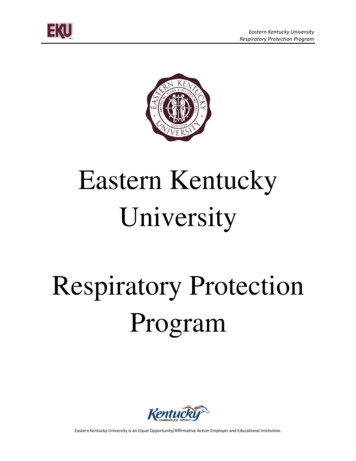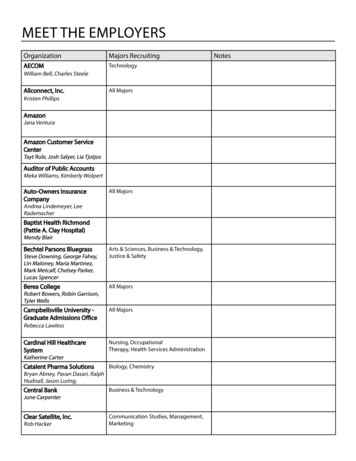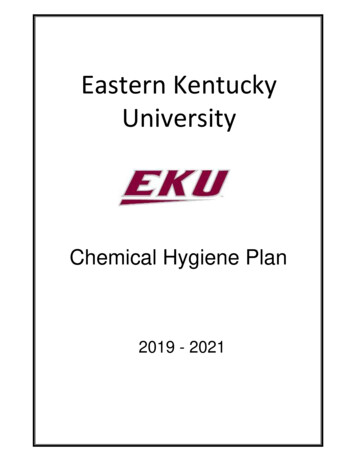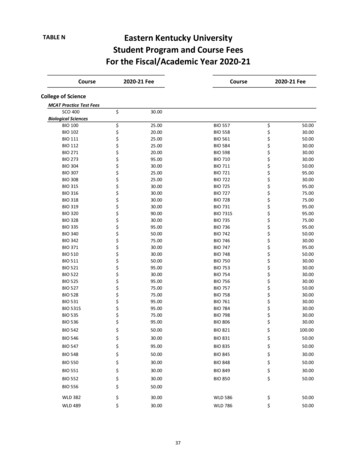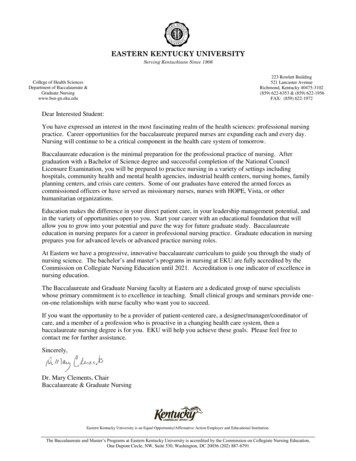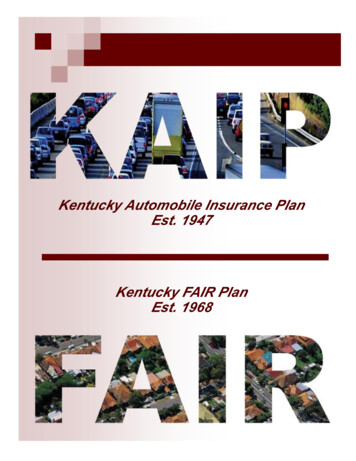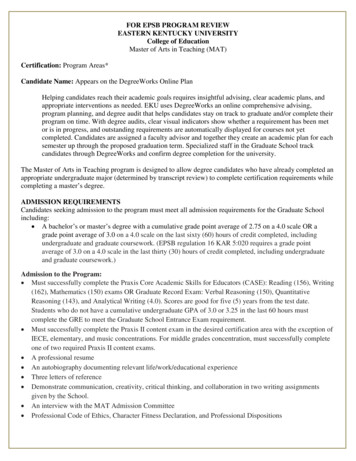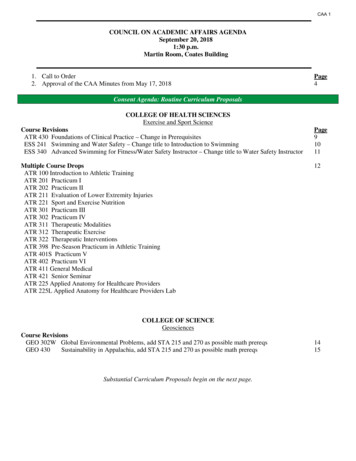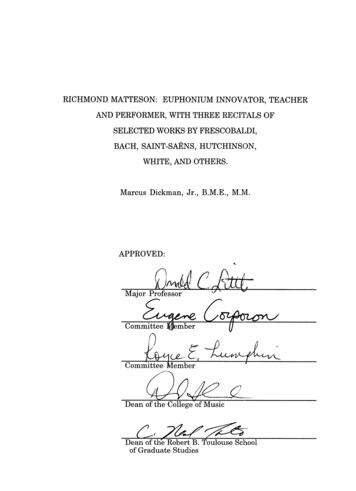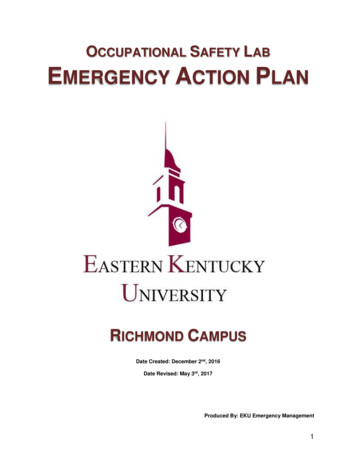
Transcription
OCCUPATIONAL SAFETY LABEMERGENCY ACTION PLANRICHMOND CAMPUSDate Created: December 2nd, 2016Date Revised: May 3rd, 2017Produced By: EKU Emergency Management1
This Page Intentionally Left Blank2
Executive SummaryThe Eastern Kentucky University Emergency Action Plan (EAP) is designed to provide basic information so that the readercan be better prepared in the event of an emergency or critical incident. The EAP is based upon the InternationalAssociation of Campus Law Enforcement Administrators’ (IACLEA) model, which is rooted in the National IncidentManagement System (NIMS). The EAP is not designed to give definitive answers for every type of emergency. Eachincident is unique and constantly evolving. Only those involved in the incident can make decisions that they believe arecorrect to ensure their own safety. The EAP provides resource material so that informed decisions can be made.This summary cannot provide detailed information about every type of incident. For more detailed information, pleaseconsult the appropriate section of the Emergency Action Plan. In order to ensure your safety, please follow the basic stepslisted below.oFires/Fire Alarms – Evacuate the building immediately and do not return until authorized by emergency responders.Always know at least two evacuation routes in case the primary evacuation route is blocked. Do not use elevators.oSevere Weather – Go to the interior of the lowest level of the structure away from windows, doors, and exterior walls.Remain there until the severe weather has passed.oMedical Emergencies – Check to ensure you are safe, check the victim, call 911 for assistance, and render aid asnecessary and appropriate to your training.oCrime and Violent Behavior – Protect yourself as best you can and contact police as quickly as possible.oHostile Intruder – Includes a physically aggressive person, hostage taker, or an active shooter. Stay as calm aspossible, avoid drastic actions that could escalate the situation, and do what is necessary to protect yourself. Thiscould include running away, hiding, playing along, playing incapacitated, or fighting (if absolutely necessary).oBomb Threats – Leave the threatened area immediately and notify responders of any suspicious items you notice. Beaware of the potential for a second threat in the evacuation area.oHazardous Material Release or Spills – Evacuate the spill area immediately and attempt to secure the area. Attemptto isolate those who have been exposed. Call 911 immediately and provide as much information about the incident aspossible.oSeasonal or Pandemic Flu – To avoid spreading germs, always cover your coughs and sneezes. Wash hands or usesanitizer regularly. If you are sick, do not come to work or class. Get a yearly flu vaccination.Being prepared is the most important step that anyone can take to minimize their risks during an emergency. Advancedplanning can save time when making decisions about what action to take during a critical incident. No document or personcan provide concrete answers about a given situation. Individuals are responsible for their own safety and to preparethemselves for emergencies. The information provided in the Emergency Action Plan is designed to provide the resourcesfor informed decision making. We encourage you to familiarize yourself with the information contained within the EAP priorto an occurrence and to review the information on a regular basis.3
This Page Intentionally Left Blank4
Eastern Kentucky University Emergency Action PlanTable of ContentsThe Eastern Kentucky University (EKU) Emergency Action Plan (EAP) is the base layer of the University’sEmergency Management Program. This function is coordinated through the Division of Public Safety and it isa collaborative effort between the Police Department, Emergency Management, Environmental Health andSafety, Risk Management and Insurance, 911, and the rest of the University Community. The EAP is meant toprovide all members of the community with important information that is relevant both at work and at home onvarious emergencies that may occur. The EAP replaces the University’s Campus Emergency Response Plan(CERP) and it is the foundation upon which each building and department can participate in craftingindividualized Building Emergency Action Plans (BEAP). The formulation of the EAP was based on theInternational Association of Campus Law Enforcement Administrators (IACLEA) Campus EmergencyOperations Planning Guide along with research, best practices, and the experience of officials within the EKUDivision of Public Safety.Section 1 (Page 7) – Building Information – Telephone Numbers – Emergency Notification SystemsSection 2 (Page 10) – Immediate Emergency Action and NotificationSection 3 (Page 12-13) – Building Alarms and Individuals with DisabilitiesSection 4 (Page 14-15) – Evacuation Procedures and Floor PlansSection 5 (Page 19) – Fire ProceduresSection 6 (Page 21) – TornadoSection 7 (Page 23) – Thunderstorms – Flooding – Power OutagesSection 8 (Page 26) – Medical EmergenciesSection 9 (Page 27) – Crime and Violent BehaviorSection 10 (Page 29) – Hostile Intruder – Hostage Situation – Active Shooter Survival GuideSection 11 (Page 36) – Psychological Crisis – EKU Faculty 911 Guide to Helping Students in DifficultySection 12 (Page 41) – Bomb ThreatsSection 13 (Page 45) – ExplosionSection 14 (Page 46) – Hazardous Material Release or Spill - CSEPPSection 15 (Page 57) – EarthquakeSection 16 (Page 59) – Civil DisorderSection 17 (Page 62) – Seasonal and Pandemic FluSection 18 (Page 67) – Custodial Services – Training and Documentation – DrillsSection 19 (Page 69) – Appendices – Acronyms – Term Definitions – Resource List – Madison CountySection 20 (Page 82) – AcknowledgementsSection 21 (Page 83) – EKU Emergency Guide Poster and Disaster Supplies5
Addendums to the Emergency Action PlanSection 22 – ESIP Buildings, CPS Control Panels, and System OperationsSection 23 – Assembly and Accountability Planning6
YOUR EMERGENCY ACTION PLANAs a member of the University Community, you should be familiar with the University Emergency Action Plan.This manual describes the procedures to follow in a variety of emergencies.As a building occupant, you need to be familiar with your specific Building Emergency Action Plan. Read it carefully. If youhave any questions, consult your Department Safety Coordinator or Building Safety Team member (See the TermDefinitions in Appendix A for an explanation of these positions).Keep the following in mind as you read this document:ooooooEvacuation routes, exit points, and where to report for roll call after evacuating the buildingWhen and how to evacuate the buildingLocations of emergency materials that may be needed in an emergency, such as fire extinguishers and fire pullalarmsProper procedures for notifying emergency responders about an emergency in the building or work area (Dial 911)Additional responsibilities, specific to your buildingRemember the following acronym: PEER – Preparing for Emergencies is Everyone’s ResponsibilityFACILITY INFORMATION(MODIFIABLE TO CREATE A BUILDING OR DEPARTMENT EMERGENCY ACTION PLAN)Facility Name:OCCUPATIONAL SAFETY LABBuilding Supervisor (BS)or Facility Leader (FL):Email:BS or FL Address:BS or FL Telephone No.:Ph:Alternate Building Supervisoror Facility Leader:Fax/Alt:Email:Alternate BS or FLCampus Address:Alternate BS or FLTelephone No.:Ph:Fax/Alt:FACILITY DESCRIPTION:The Occupational Safety Lab is a single story steel constructed building.This building is used as a classroom with working lab areas for EKU students.EAA LOCATION:The Emergency Assembly Area location is in the Parking Lot on the South side of the building.7
Departments (Modifiable to Create a Building or Department Emergency Action Plan)List the departments with employees in your ding / Facility Safety Team (Modifiable to Create a Building or Department Emergency Action Plan)All departments with employees in your building should be represented on your team.List team members and positions (chair, vice-chair, other officers, members, etc.).NameDepartmentPhoneBuildingRoomCritical Operations (Modifiable to Create a Building or Department Emergency Action Plan)In this section, include information about critical operations that require special care during an emergency. These areasshould have their own plans to ensure the safety and security of materials and information housed there. Be sure to checkwith each department before completing this section. Employees may need to notify University Police and RichmondFire/Rescue Departments about the following critical operations:OperationRoomDepartmentResponsible PersonPhone8
EMERGENCY NOTIFICATION SYSTEMSEastern Kentucky University has implemented a multi-modal emergency notification system to inform the communityabout incidents and emergencies affecting campus. Realizing that message redundancy is a necessity, EasternKentucky University has seven primary notification systems available for the community. Any one, or a combination, ofthe alert methods listed below may be used depending on the nature and severity of the event.The primary message creator and/or sender is a Public Safety Team Member. A Public Safety Team Member is anyone of the following positions: Telecommunicator, Police Supervisor (i.e. Lieutenant / Sergeant), Compliance & TelecomManager, Emergency Manager, Chief of Police, and/or Executive Director of Public Safety. Each position has theauthority to create and/or send Emergency Notifications and/or Timely Warnings. Each position serves as a back up tothe other positions. The message creator and/or sender is the most available team member with the most current andrelevant knowledge about the situation. Alert methods to be used are determined by the message creator/sender basedon the nature and severity of the event. Alert methods have been pre-determined for various events, however, methodsmay be altered as deemed appropriate by the message creator/sender.The Regional Campus Directors, and certain other administrators are authorized and responsible for creating andsending Emergency Notifications and/or Timely Warnings specific to their campuses.New technologies and other Emergency Notification Systems are periodically explored and evaluated. This section issubject to change as technology changes.Systems Include: Siren/Public Address System - Audible sirens and announcements can be broadcast over four loudspeakersstrategically placed on campus. This system can be activated by the EKU Division of Public Safety as well asthe Madison County Emergency Management Agency for weather and community emergency notifications.Text Messaging - An opt-in notification where a text message can be received on your mobile phone. EKUdoes not charge for this service; however, your carrier may have standard text messaging charges.Voice Messaging - An opt-in notification where a voice message can be received on your mobile or homephone. (Important: Students should re-enroll their mobile phone numbers at the beginning of each semester)Email Messaging - This notification provides an email message about an event. Current students, faculty,and staff are automatically registered to receive notifications on their EKU email account and cannot opt-outof this type of notification. You can opt-in to receive emails on other email accounts. Community members areencouraged to check their email, frequently throughout the day, to be sure they see any message sent by thisalert method.RSS Feeds - A message can be posted on the Emergency Management, Police Department, or Universityweb pages.Network Messaging - A visual notification can be made across computers connected to the EKU network.This requires a program to be installed on your computer that monitors the server. When an alert is sent out,a pop-up box appears on your screen. No personal information is gathered or transmitted with the use of thisalerting system.Social Media - EKU can use Twitter and Facebook to send notifications to the community. These socialsystems require the user to check to receive any messages posted. Follow @EKUEmergency on Twitter andLIKE EKU Emergency Management on Facebook.To Register:Current Students, Faculty, and Staff: Log on to EKU Direct (https://web4s.eku.edu/pls/prod/twbkwbis.P WWWLogin) with your EKU ID and PIN. Under the Main Menu, click the Rave Mobile Safety - Emergency Notifications link. Register to receive text, voice, and/or email messaging. *Note: Email messages are automatically sent to allcurrent EKU email addresses and you cannot opt-out of receiving messages on your EKU email account. To receive text and voice messages you must opt-in by entering your telephone number(s).Other Community Members: Goto the Rave Site Look-up and search for Eastern Kentucky University (http://www.getrave.com/login/eku). Click the Register Button in the upper right hand corner. Register your information and select to receive text, voice, and/or email messaging.Network Messaging:All EKU issued PC's have the Alertus network messaging program installed. If you wish to have the program installedon your personal PC or a MAC, please email Gary Folckemer (gary.folckemer@eku.edu).9
EMERGENCY PROCEDURESImmediate Emergency Action – Calling for Help and NotificationsEMERGENCY ACTIONIn a Life-Threatening Emergency - Dial 911From a Campus or Public Telephone or use an Emergency Call Box.Dial 911 from your cell phone (Off Campus) andDial 859-622-1111 or 859-622-2821 from your cell phone (On Campus).Program these numbers into the speed dial function of your cell phone.1.Protect Yourself First – Create and Manage Distance and Shielding from ThreatsGenerally, the farther you move away from a threat, and the more solid and stableobjects that you position between you and a threat, the safer you are from that threat.2.Call 911 or 859-622-1111 or 859-622-2821ooooGive your name, location, and phone number.Describe the nature of the incident and its location.Describe any injuries, weapons, hazards, devices, and property involved.Describe the people involved, where they are, and where they went.ooooStay on the line with the Dispatcher until help arrives.Keep the Dispatcher updated on any changes so responding units can be updated.Even if you cannot communicate, keep the line open.The Dispatcher may be able to learn more about what is happening.(Note)Dialing 911 from an on campus (land line or corded) telephone, using an emergency call box, or dialing859-622-1111 or 859-622-2821 from a cellular phone will connect you to the EKU Public Safety Dispatch Center.Dialing 911 from a cellular phone or dialing 859-624-4776 will connect you to the Madison County 911 Center.In any case, you can summon the help you need – Police – Fire – Rescue – HAZMAT – EMS.INFORMATION NUMBERSDepartment Telephone Number:See Departments Listed on Page 8.Police: Eastern Kentucky University Police Department911 (Campus Phone) or 859-622-1111 or 859-622-2821 (Outside / Cell nd Fire/Rescue Department911 (Emergency) or 859-624-4776 or 859-623-1164 (Non Emergency)http://fire.richmond.ky.us/Ambulance: Madison County Emergency Medical Services (EMS)911 (Emergency) or 859-624-4776 or 859-623-5121 (Non Emergency)http://www.madisoncountyky.us/Medical Facilities:EKU Student Health Services521 Lancaster Avenue103 Rowlett BuildingRichmond, KY /10
Baptist Health Richmond789 Eastern By PassRichmond, KY .com/richmond/Other Area Hospital Systems:University of Kentucky Health Care859-257-1000 or d Samaritan /ed/Saint Joseph Health /saintjosephhospitalBaptist Health ucky.com/lexington/Occupational Medicine Center646 University Shopping CenterRichmond, KY 40475859-623-0535859-623-1950 (Instant Care Center for after hours)EKU Counseling Center521 Lancaster Avenue571 Student Services BldgRichmond, KY ison County Health Department216 Boggs LaneRichmond, KY 40475859-623-7312Disability Support Services: EKU Office of Services for Individuals with Disabilities ties Services: EKU Facilities Services ion Technology: EKUITHelpdesk 859-622-3000http://www.it.eku.edu/Environmental Health and Safety: 859-622-2421 or 859-622-1111http://ehsrmi.eku.edu/Kentucky Environmental Emergency Response Hotline: 502-564-2380 or 800-928-2380Lexington Fayette Urban County Government DEEM: 859-258-3784Lexington Fayette Urban County Government Emergency Operations Center: 859-258-3970Madison County Emergency Operations Center: 859-624-478711
Madison County Joint Information Center: 859-624-4753National Response Center (NRC): 800-424-8802Richmond Utilities (Gas, Water, Sewer): 859-623-2323Kentucky Division of Water: 502-564-3410Kentucky Division for Air Quality: 502-573-3382Kentucky Division of Waste Management: 502-384-4734Spill Response Contractor: Pecco, Inc.: 859-887-5508Poison Control Center: 1-800-222-1222Building Alarm(s)Indicate all of the alarms that occupants should be able to identify. There may be several alarms in or near your building,such as evacuation alarms, elevator alarms, biosafety hood or fume hood alarms. Describe the different sounds, thesignificance of each alarm, and the appropriate occupant response to each alarm. Add other steps, actions, orprecautions specific to your building or work area.Fire AlarmThere is No Fire Alarm System in the Occupational Safety LabEvacuation should be Accomplished through Voice or TouchDirecting Occupants to Leave the Area.Any Person May Order an Evacuation if they Perceive Danger in the Area.Because There is No Automatic Monitoring, Someone Must Call 911 to Report the Emergency.If you hear any other alarm that you do not recognize, use caution, protect yourself, contact EKU Public Safety at 911or 859-622-1111, and report the alarm.Evacuation PlanUpon being alerted to an emergency requiring evacuation, all occupants should immediately leave their area, closingthe doors behind them, and proceed to the nearest exit or exit stairway. Occupants should exit or ascend/descend thestairs and exit in an orderly manner. Upon exiting the building, all occupants should gather in the Emergency AssemblyArea.The Emergency Assembly Area location is in the Parking Lot on the South side of the building.This plan was and can be further developed with input from the staff of EKU Public Safety, taking into account specificbuilding and occupant needs. EKU Public Safety can be reached at 859-622-1111.Sheltering In PlaceBecause sheltering in place may be the protective action recommendation for several emergencies with differingrisks, and because sometimes the initial recommendation is to shelter in place followed by relocation, there is nosingle set of shelter in place procedures. Based on the type of emergency, such as Tornado, Hostile Intruder, orHazardous Material Release Outside, you should consult each relevant section for guidance.Emergencies change as they progress. The questions to ask yourself are:Am I safer inside or outside? Where am I safest inside? Where am I safest outside?DisabilitiesWith regard to persons requiring assistance in evacuation:The Occupational Safety Laboratory has 2 entrance/exit doors, at the front and rear of the facility,exit outside at grade and are accessible for individuals with mobility impairment.12
If someone with mobility impairment cannot exit they may take refuge in a room.Your safety is very important to EKU. Maintaining your safety is a joint responsibility
Eastern Kentucky University Emergency Action Plan Table of Contents The Eastern Kentucky University (EKU) Emergency Action Plan (EAP) is the base layer of the University’s Emergency Management Program. This function is coordinated through the Division of Public Safety and it is .

